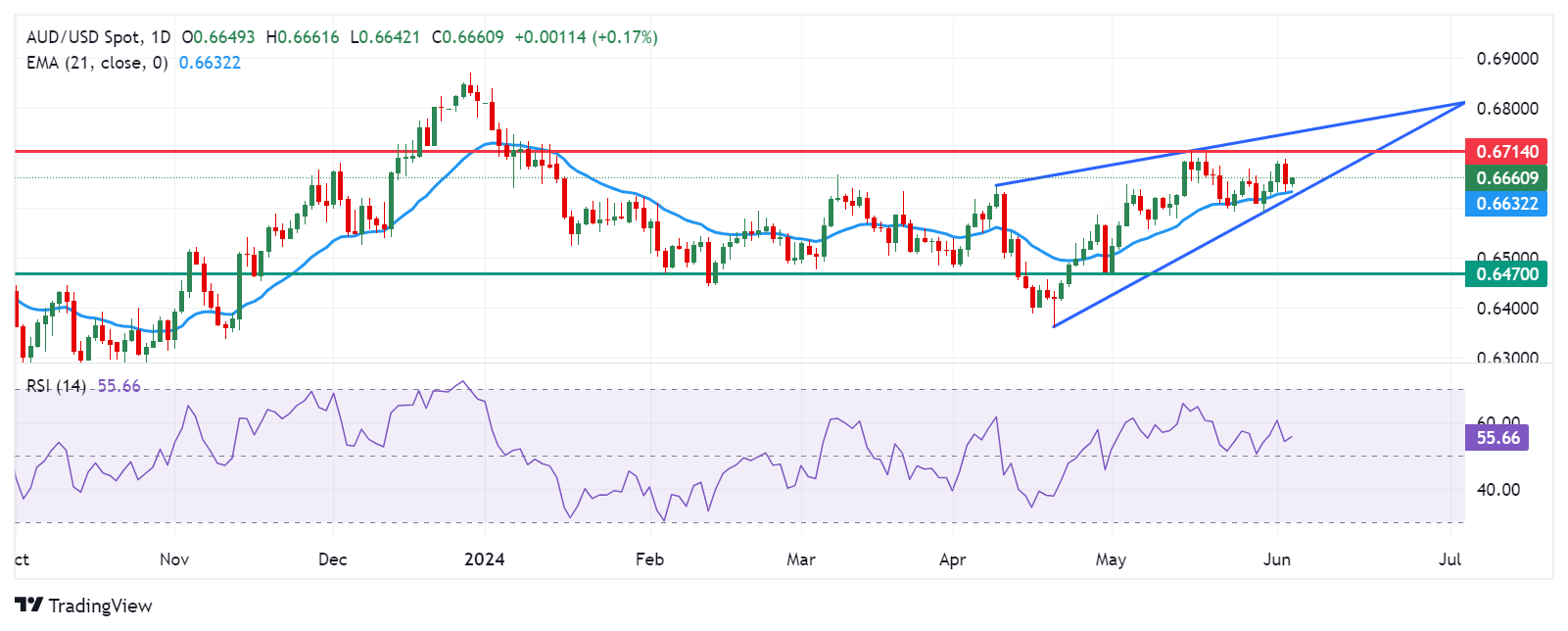- The Australian Dollar appreciates as RBA Governor Michele Bullock stated to increase rates if the CPI does not return to the target range.
- Australia's GDP grew 0.1% QoQ in the first quarter, falling short of the expected 0.2% reading.
- Caixin China Services PMI came in at 54.0 in May, marking the 17th consecutive month of expansion in services activity.
- The US Dollar could rebound due to the higher US Treasury yields.
The Australian Dollar (AUD) gains ground as the Reserve Bank of Australia (RBA) Governor Michele Bullock stated on Wednesday that the central bank is prepared to increase interest rates if the Consumer Price Index (CPI) does not return to the target range of 1%-3%, as reported by NCA NewsWire.
The upside of the Aussie Dollar could be limited due to the lower-than-expected Gross Domestic Product data, which grew 0.1% QoQ in the first quarter, against the expected 0.2% reading. On an annual basis, the economy grew 1.1%, slightly below the expected 1.2%. The AUD/USD pair received pressure as the Judo Bank Purchasing Managers Index (PMI) came in at 52.5, lower than the expected reading of 53.1 for May.
The US Dollar (USD) could rebound due to the upward correction in US Treasury yields. The USD weakened on the back of rising speculation of an interest rate cut by the Federal Reserve (Fed) this year. Investors await the key US data releases later on Wednesday, including the US ADP Employment Change and ISM Services PMI reports.
Daily Digest Market Movers: Australian Dollar appreciates despite softer economic growth
- The Judo Bank Composite PMI recorded a reading of 52.1 in May, a slight decrease from 53.0 in April. This shows that Australia's private sector output continued to grow for the fourth consecutive month, though at a slower rate.
- Caixin China Services PMI came in at 54.0 in May, surpassing expectations of 52.6 and the previous figure of 52.5. This marked the 17th consecutive month of expansion in services activity, indicating the fastest pace since July 2023. Any change in the Chinese economy could impact the Australian market as both countries are close trade partners.
- The JOLTS US Job Openings declined by 296,000 to 8.059 million in April, down from March's 8.355 million, marking the lowest level since February 2021. This figure also missed the market consensus of 8.340 million, data showed on Tuesday.
- Australia reported on Tuesday a current account deficit of A$4.9 billion (USD 3.2 billion) in the first quarter, marking a significant shift from a downwardly revised surplus of A$2.7 billion in the previous quarter. This result missed market expectations, which had anticipated a surplus of A$5.9 billion.
- The ISM Manufacturing PMI unexpectedly dropped to 48.7 in May, down from April's reading of 49.2 and below the forecast of 49.6. The US manufacturing sector experienced its second consecutive month of contraction.
- Australia’s Judo Bank Manufacturing PMI was released on Monday, edging up slightly to 49.7 in May from 49.6 in April, marking the fourth consecutive month of declining conditions in the manufacturing sector.
- On Monday, the Caixin China Manufacturing PMI rose to 51.7 in May from 51.4 in April, marking the seventh consecutive month of expansion in factory activity and surpassing the estimates of 51.5. Friday’s NBS PMI data showed that manufacturing activity fell to 49.5 in May from 50.4 in April, missing the market consensus of an increase to 50.5. Meanwhile, the Non-Manufacturing PMI declined to 51.1 from the previous reading of 51.2, falling short of the estimated 51.5.
Technical Analysis: Australian Dollar hovers around 0.6650
The Australian Dollar trades around 0.6650 on Wednesday. A daily chart analysis indicates a bullish bias for the AUD/USD pair, as it remains within a rising wedge pattern. Additionally, the 14-day Relative Strength Index (RSI) is slightly above the 50 level, reinforcing this bullish bias.
The AUD/USD pair could potentially target the psychological level of 0.6700, followed by the four-month high of 0.6714 and the upper limit of the rising wedge around 0.6750.
On the downside, immediate support is seen at the 21-day Exponential Moving Average (EMA) at 0.6632, followed by the lower boundary of the rising wedge and the psychological level of 0.6600. A further decline could exert pressure on the AUD/USD pair, potentially pushing it toward the throwback support region at 0.6470.
AUD/USD: Daily Chart

Australian Dollar price today
The table below shows the percentage change of the Australian Dollar (AUD) against listed major currencies today. The Australian Dollar was the strongest against the Japanese Yen.
| USD | EUR | GBP | CAD | AUD | JPY | NZD | CHF | |
| USD | 0.08% | 0.04% | 0.00% | -0.14% | 0.42% | -0.09% | 0.17% | |
| EUR | -0.09% | -0.05% | -0.08% | -0.21% | 0.36% | -0.16% | 0.09% | |
| GBP | -0.04% | 0.03% | -0.04% | -0.17% | 0.40% | -0.12% | 0.13% | |
| CAD | -0.01% | 0.08% | 0.03% | -0.13% | 0.46% | -0.08% | 0.19% | |
| AUD | 0.14% | 0.22% | 0.17% | 0.14% | 0.58% | 0.06% | 0.31% | |
| JPY | -0.42% | -0.37% | -0.40% | -0.45% | -0.58% | -0.53% | -0.27% | |
| NZD | 0.09% | 0.17% | 0.13% | 0.09% | -0.05% | 0.51% | 0.26% | |
| CHF | -0.17% | -0.09% | -0.14% | -0.17% | -0.30% | 0.27% | -0.25% |
The heat map shows percentage changes of major currencies against each other. The base currency is picked from the left column, while the quote currency is picked from the top row. For example, if you pick the Euro from the left column and move along the horizontal line to the Japanese Yen, the percentage change displayed in the box will represent EUR (base)/JPY (quote).













